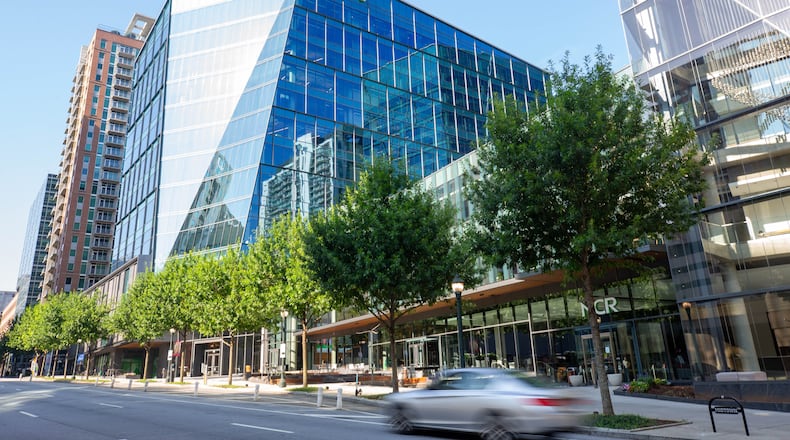Metro Atlanta has too much available office space to rent and not enough companies willing to fill up the office parks and skyscrapers that define the region’s skyline.
Roughly a quarter of the total office space in the metro area is considered vacant. But when factoring in space that companies are renting but no longer want — known as space available for sublease — the picture gets worse.
Between vacant and sublease space, nearly 30% of all office square footage in metro Atlanta is available for rent, a record high, according to data from real estate services firm CBRE.
All the vacant and listed subleased space totals some 44 million square feet. How much empty or unwanted space is that? It’s like trying to fill the city’s tallest tower — Bank of America Plaza — 34 times.
This despite unemployment in metro Atlanta being near record lows and waves of new jobs announcements pouring in every month.
Large companies continue to grapple with how many of their employees will return to a physical workplace each day since the worst of the pandemic. Some employers are condensing their footprints when their leases end, while others are listing space they’ve rented but no longer need on the sublease market.
Metro Atlanta’s sublease space is roughly triple pre-pandemic levels, meaning more companies are looking to rent their unused office space to other tenants for discounted prices. The glut of sublease space is primarily driven by the metro area’s largest employers placing entire buildings and corporate campus wings on the market.
Amber Schiada, JLL’s head of Americas work dynamics and industries research, said the office market is still months, if not years, away from normalizing after COVID-19 upended traditional workplace habits. The problem is nationwide, not just in Atlanta.
“If I were to put it in baseball terms, I would say we’re in the seventh inning of figuring out what return to work and that hybrid reality looks like,” she said during the National Association of Real Estate Editors conference in June.
The news isn’t just bad for office landlords that rely on rents to pay off mortgages and lease up their buildings to supersize returns for their investors. Commercial properties are key parts of city, county and school tax digests, and fuller buildings are worth more than emptier ones.
And businesses near office buildings — such as restaurants, hotels and shops — rely on revenue from white collar workers.
Leasing is weak and interest rates are high making it difficult for landlords to sell at prices high enough to pay off their debts or to refinance loans coming due, which cut further dent commercial property values.
Credit: Jason Getz/AJC
Credit: Jason Getz/AJC
Ellen Stern, a senior vice president with CBRE’s Atlanta Advisory and Transactions Occupier Group, said many companies are making the most of smaller spaces as they tweak their post-pandemic office needs.
“They’re doing more with less space,” she told The Atlanta Journal-Constitution. “The amount of dedicated space per employee is generally less.”
At the end of this year’s second quarter, real estate services firm Avison Young reported more than 8.4 million square feet of sublease space was on the market, a 37% increase from the same time last year. The amount of available sublease space could fill the floor space of Bank of America Plaza more than six times.
Several large companies have placed hundreds of thousands of square feet on the sublease market in recent months, including Home Depot, Anthem, IBM, Serta Simmons, Global Payments and Cox Automotive Group — whose parent company, Cox Enterprises, also owns the AJC.
“All of those have such big footprints that it makes a splash to the overall sublease inventory,” Stern said. “But it is reflective of what many tenants are doing no matter their size.”
NCR, a Fortune 500 company that is preparing to split into two independent public companies later this year, last month put a portion of its Midtown campus on the sublease market. The automated teller and financial technology company has declined to comment since listing a 14-story tower that includes 277,000 square feet of office space.
Casey Keitchen, a principal in the Avison Young Capital Markets Group in Atlanta, said putting unused space on the market is an easy decision.
“They’re just looking for ways to save money,” he said. “But just because the tenant puts something out for sublease doesn’t mean necessarily that they’ll never utilize the space again.”
Stern said there’s little demand for gigantic offices right now. She said companies have to follow the demand, which is catering to smaller office users.
“If you have a sublease where you have a big space that you’re marketing, you have to be open to subleasing it in smaller chunks,” she said.
That also means companies can find prime locations at steep discounts.
Office tenants, both primary lease holders and those with subleases, are signing shorter contracts for fear of overcommitting to their office footprint, experts said. Scott Ziegler, senior principal with Texas-based Ziegler Cooper Architects, said the average new lease across the country is close to three years, compared to nearly five years in 2020.
“It shows the cautiousness of the end user by not wanting to overcommit as they try to figure out their hybrid space and how all of this will play out,” he told the NAREE conference in June.
Stern said the commercial real estate world is waiting for more companies to require their employees to come to the office, at least part-time, rather than fully work from home. She said that will help give companies a better idea of their office needs.
“When you look at the list of companies issuing mandates for their employees to return to the office, that list is getting longer and longer,” she said. “And I think that’ll translate well into increased leasing volume in the next year to 18 months. That will slowly chip away at the sublease space.”
Space for rent
Metro Atlanta had a record amount of available office space at the end of June, according to data from CBRE. Here’s how it breaks down:
Office vacancy rate: 23.5%
Space available for sublease: 6.3%
Overall rate of available space: 29.8%
About the Author
Keep Reading
The Latest
Featured


